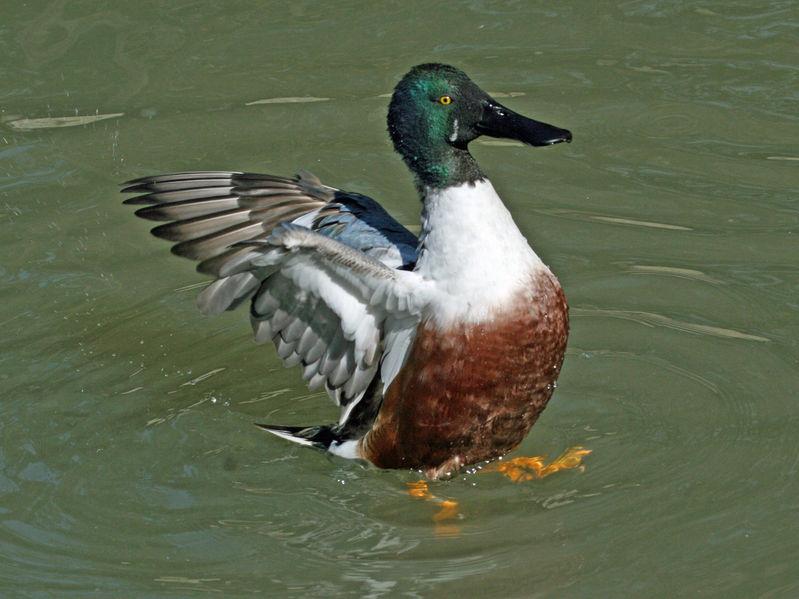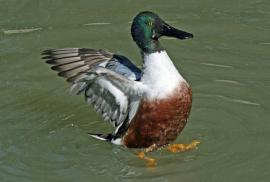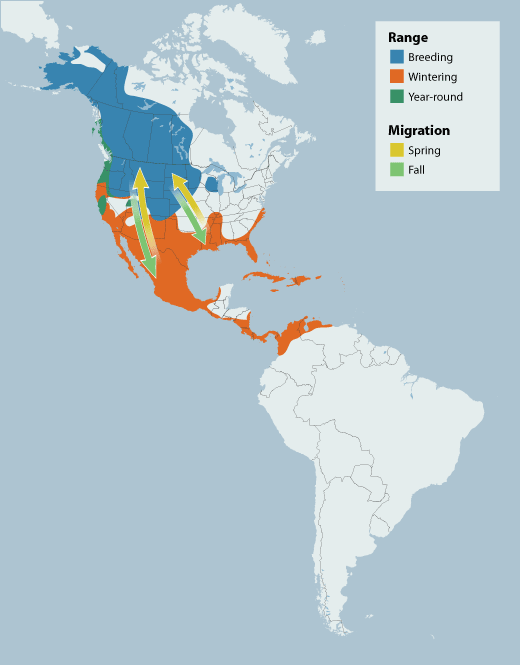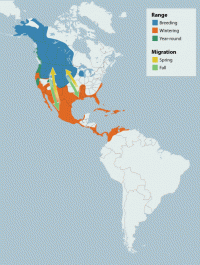Guide to Boreal Birds
This is an in-depth boreal species profile.
What is this?
This species is one of more than 30 birds selected for in-depth profiles. Find out why and see all selected boreal birds »
Overview
Northern Shovelers, related to the Blue-winged and Cinnamon teal, are often referred to as the "Spoonbill" or "Spoony" because of their unique spatulate shaped bill. Breeding males are distinguished by a green/black head, white belly, rufous flanks and black bill. Females show similar body patterns as males but tend to be more gray and their bills are orange, speckled with black. At a casual glance, individuals can easily be mistaken for mallards but can be distinguished from them by the large blue patch they display on their shoulder and their iridescent green speculum (a lustrous colored patch on the wing) as opposed to the absence of a shoulder patch and violet blue speculum of the mallard
This bird favors broad, shallow marshes where it can use the comb-like teeth along the edges of its large bill to strain aquatic animals, plants, and seeds from the water. Like the two teal, male shovelers wear eclipse plumage until February, much later than ducks whose courtship begins in the fall. Though less numerous than in ancient times, the Northern Shoveler and other marsh ducks have lately become relatively abundant because game departments and private organizations in Canada, the United States, and Mexico have purchased wetland habitat to ensure their survival.
Description
17-20" (43-51 cm). Large shovel-shaped bill. Male has green head, white body, and chestnut flanks. Female streaked brown with pale blue shoulder patches; similar to female Blue-winged Teal, but bill much larger.
Voice
Low croak, cluck, or quack.
Nesting
8-12 pale buff or greenish eggs in a down-lined cup of grass concealed in vegetation, often some distance from water.
Habitat
During the breeding season, Northern Shovelers are widely distributed throughout North America, Europe and Northern Asia. They normally inhabit open, shallow and muddy freshwater wetlands that house a large abundance of submergent vegetation. These wetlands are usually adjacent to open grassy areas, which provide sufficient cover for nests. Similar habitats are used during spring and fall migration.
In the fall, Northern Shovelers migrate to the southern regions of North America, South America, North Africa and Southern Asia to over winter. Freshwater and saline marshes, industrial cooling ponds, agricultural wastewater ponds, coastal lagoons, estuaries and mangrove swamps provide wintering habitat.
Range/Migration
This species follows an annual migration that consists of 2 periods: spring and fall migration. As one of the latest spring migrants of all the dabbling ducks, the majority of individuals depart from their wintering grounds late March to arrive at their destined breeding grounds late April or early to mid May.
As early fall migrants, males do not undergo an extensive molt migration and depart from their breeding grounds in late August or early September. Male migration is considerably earlier than female and young of the year who depart latter September and October.
Northern Shovelers migrate in small isolated flocks of 10-25 individuals and travel both day and night. In North America, 2 main migration corridors are favored. One passage extends along the Mississippi and Missouri Valleys, through the central plains to the Gulf Coast and Central Mexico. The second migration corridor extends from Western Canada through the intermountain regions of California and down to the west coast of Mexico.
Breeding
The breeding season for Northern Shovelers begins on the wintering grounds in December, where courtship of hens by a group of drakes commences. By January, the majority of individuals have paired before they start their spring migration and most return to the same breeding grounds they used the previous year. Once on the breeding grounds, males defend their females and territory strenuously while the females locate nest sites and begin nest construction.
Nesting occurs in early to mid May where females will spend 6-8 days selecting a nest site and begin construction. Nests are built on the ground, sheltered by grass and are generally 75-200 feet from a water body. When grassy areas are not available, the nest may be situated in hay fields, meadows and less commonly in bulrushes. Females begin nest construction by scratching the ground and lining the hollow with plant material, down and feathers.
Females will usually lay 1 egg a day until a clutch of 8- 12 pale olive or pale greenish-gray eggs is deposited. The eggs are incubated for 20-25 days until they synchronously hatch. Within 24 hours of hatching, the hen leads the young away from the nest to the water. Within 8 weeks of hatching, the young fledge. It is common for the male to abandon the female during the incubation period.
Nest success is dependent on factors such as predation and nest parasitism. The majority of nest failure results from predation by small mammals such as the Red Fox (Vulpes vulpes), Striped Skunk (Mephitis mephitis), American Mink (Mustela vison), raccoon (Procyon lotor), Badger (Taxidea taxus) and Franklin's ground squirrel (Spermophilus franklinii). Other offenders include various corvids, gulls and raptors. Nests are also subjected to nest parasitism by Redheads (Aythya Americana) and Lesser Scaup (Aythya affinis). Some individuals will re-nest if their initial nest has been destroyed or fails.
Diet/Feeding Behavior
With vegetation constituting 60% its diet, Northern Shovelers tend to forage on water bodies that are high in plant diversity. Vegetated water bodies provide seed from various plants including pondweed, bulrush, various grasses, sedges and algae. The remainder of its diet consists of mollusks, aquatic insects and zooplankton. More specifically, they prefer to forage on animals such as fingernail clams, water boatmans, midge and caddis fly larvae, and copepods and ostracods.
The unique bill morphology of Northern Shovelers allows this species to exhibit one of the most unusual feeding behaviors of any duck. Its large spoon shaped bill is adapted for sifting large amounts of muddy water. Their tongues are highly specialized with extensive comb-like teeth called lamellae, which help filter food items from the water. Moving its head side to side, water is drawn in at the tip of the bill, filtered through the lamellae to pick up any food particulate and then expelled at the base.
Socially, these dabbling ducks occasionally work together in groups while feeding, rotating like a 'pin-wheel', stirring up the surface water and skimming it for food particles. They also dabble through muddy bottoms in shallow ponds and will occasionally dive and feed underwater in deeper water bodies.
References
Bellrose, F.C. 1980. Ducks, geese, and swans of North America. Rev. ed. Stackpole Books, Harrisburg, PA.
Beauchamp, W.D., Koford, R. R., Nudds, T.D., Clark, R. G. and Johnson, D. H. 1996. Long-term declines in nest success of prairie ducks. Journal of Wildlife Management 60: 247-257.
Bethke, R. W. and Nudds, T.D. 1995. Effects of climate change and land use on duck abundance in Canadian Prairie-Parklands. Ecological Applications 5: 588-600.
Dubowy, P. J. 1997. Long-term foraging optimization in Northern Shovelers. Ecological Modelling 95:119-132.
Dubowy, P.J. 1996. Northern Shoveler. The Birds of North America. No. 217. (A. Poole and F. Gill, Eds.). Philadelphia: The Academy of Natural Sciences; Washington, D.C.: The American Ornithologists' Union.
Federation of Alberta Naturalists, 1992. The Atlas of Breeding Birds in Alberta. Edited by Glen P. Semenchuk. Published by the Federation of Alberta Naturalists, Edmonton, AB.
Klett, A.T., Shaffer, T. L. and Johnson, D. H. 1988. Duck nest success in the prairie pothole region. Journal of Wildlife Management 52: 431-440.
Credits
Birding content provided by National Wildlife Federation/eNature, with support from Ducks Unlimited/The Pew Charitable Trusts.





